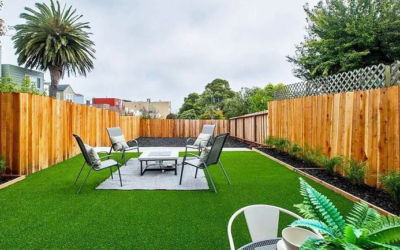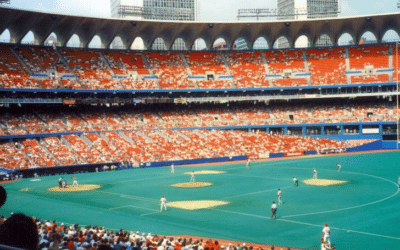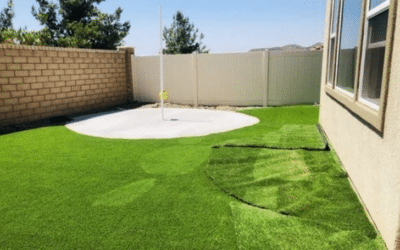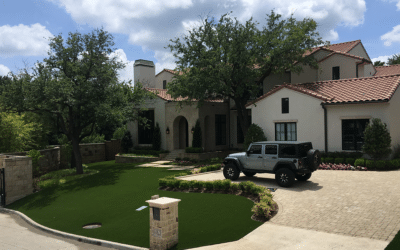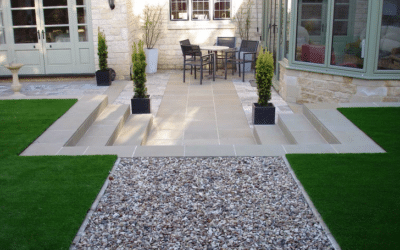Artificial grass vs. real grass is a comparison made by more and more homeowners across the U.S.
Homes and businesses are switching to synthetic turf from real grass at an increasing rate—and comparing the head-to-head qualities of each can be revealing.
Let’s see how they shape up in some of the main categories so that you can make an informed decision about which is best for your home…
Artificial Grass vs Real Grass Comparison

How does artificial grass measure up against natural grass in the main categories? There are many pros and cons of each, whether you’re looking to install in the backyard or front yard…
Appearance
Around 30-40 years ago, there was only one winner in this category: real grass looked and felt better than fake grass.
However, as the technology has developed, you can now get artificial grass that closely resembles the real thing—so much so that it can be tough to tell the difference between the two. The multicolor grass blades, layer of thatch, different blade shapes, and multiple textures of the best artificial grass perfectly mimic real grass.

For some homeowners, the inconsistent appearance of real grass and the changes it goes through around the year (bald spots and all) are preferable. However, if you want a lush grass area that looks green, pristine, and the perfect length all year round without breaking your back with effort, high-quality synthetic grass is the way to go.
Touch and Odor
Artificial grass is virtually odorless once it’s been installed for a few days. You won’t get the smell of freshly cut grass that some people love because there’s no mowing or trimming.
As technology has improved, the lush softness of real grass has been replicated by artificial grass. You’ll find turf lawns, turf strips, and other synthetic grass areas soft and comfortable for walking barefoot.

Installation Costs
The installation costs of high-quality artificial grass are higher than for real grass but that’s only part of the story. You also need to consider the ongoing costs and the overall return on investment (see the next two sections).
Real grass requires either seeding or laying sod. These involve quite low costs compared to artificial grass, which makes it an attractive option if upfront funds are limited.

Ongoing Costs
After real grass is laid, you need to pay for fortnightly or monthly care from professionals or do it yourself. Either way, there are significant costs involved in water, irrigation systems, lawnmower fuel, pesticides, fertilizer, garden tools, and so on.
With artificial grass, the ongoing costs are practically zero because of the lack of maintenance needed to keep it looking immaculate. Fake grass can get by with no water, which cuts the monthly water bills significantly.

Return On Investment
An artificial grass lawn pays back the extra installation costs after about five or six years. After that time, you save money year after year compared with real grass. This makes artificial grass more than worth the money.
The return on investment between years 6-15 and beyond for artificial grass is the great economic benefit it has over natural grass. You might even find that a top-quality synthetic grass installation increases the value of your home.

Maintenance Requirements
The virtually maintenance-free nature of artificial grass is a leading reason why many homeowners switch from real grass.
Real grass requires a lot of upkeep to maintain its appearance all year round and prevent overgrowth, bald spots, burrowers or other problems. Synthetic grass requires no watering, cutting, fertilizing, weeding or aerating and is always the right height.
The most that artificial turf needs is an occasional hose down and a cross-brush. This saves countless evenings and weekends spent in the yard.

Irrigation/Drought Tolerance
There’s no contest here. Real grass requires heavy watering in many areas of the country and many homes with sizable grass lawns have sprinkler systems. These can guzzle water, which can be a problem in drought-prone areas, like large parts of the south.
Artificial grass, on the other hand, is drought-tolerant and requires little water to look the part. An occasional hose down may help remove dust and debris from the surface but this is a tiny fraction of the water required to keep real grass healthy.

Sun and Shade Tolerance
Real grass needs a good amount of sunshine as well as water to flourish. A permanently shaded area can prevent healthy growth and grass that receives too much sunshine may start to show signs of drying out.
Artificial grass needs neither and can be installed in sunny and shaded areas alike. Synthetic turf gets a little hotter than real grass in summer but the best varieties have inbuilt cooling mechanisms. Some cheaper varieties may suffer from excessive heat and begin to “melt”.

Longevity
Did you know that a blade of grass only lives an average of 40 days before it dies? It replenishes itself but after a while, the rate of replenishment may fall behind the rate of dying grass.
So, overseeding may be required—especially in heavy traffic areas, if water is scarce or if aeration is not performed.

Artificial grass., on the other hand, can easily last 15-20 years with only occasional maintenance.
Durability
Heavy foot traffic, sports, and boisterous kids’ play can be damaging for real grass, often leading to bare spots, heavy matting, and discoloration—unless you select a hardy type of grass that can withstand the wear and tear.
The best artificial grass is manufactured to withstand moderate to heavy foot traffic. You can feel confident that it will be durable enough to withstand constant usage by children, pets, and the rest of the family. Artificial turf is even installed in heavily used commercial areas because of its durability.

Drainage
How do real and artificial grass compare after heavy rains?
Real grass has a natural drainage system as water escapes through the soil but, depending on the type of grass/soil, the area can become waterlogged and muddy.

There are no such issues with the best types of artificial grass, which have an excellent drainage rate of 30 inches per hour. Water won’t pool on the surface and there’ll be no mud or mess if your kids or pets play on it after rain.
Usability
Artificial grass has very little “downtime” and remains usable all year round—even after heavy rains or snow and with no maintenance.
Real grass may suffer from excessive mud in wet conditions or dry, balding patches if it’s particularly dry. This makes it less usable as well as less picturesque.

Health and Safety
Both real and artificial grass are generally safe and healthy for the family—but real grass needs more effort to remain that way.
High-quality artificial grass is allergy-free and usually needs only occasional cleaning to stay bacteria-free and hygienic. Real grass can harbor bacteria, allergens, and other health risks and may need treatment with herbicides and pesticides to remain insect-free, which may increase the exposure to toxins for your family,
Some people consider artificial grass to be more slippery than real grass—and therefore the cause of more fall injuries—but this applies mainly to lower-quality turf. Besides, this is balanced out by the perfectly flat, divot-free surface it offers, which is not usually the case with real grass.

Suitability for Pets and Kids
Real grass lawns need fertilizers, pesticides, and other chemicals, so the toxic load may be less suitable for children and pets than an artificial grass lawn.
Artificial grass is frequently used for kids’ playgrounds, sports fields, dog runs, and other areas used by children and pets. Not only is the surface flatter, rock-free, and hypoallergenic but no muddy paws or feet will trail back through the house—and no grass stains will need cleaning off clothing!
For play areas and sports fields, the artificial grass is installed over a shock-absorbent layer, which effectively absorbs impact.

Suitability for Pool Areas
Real or artificial grass can be used around swimming pools without too many concerns—though both types of grass may get slippery when wet. The best artificial turf drains well and has a sturdy grip to prevent wet feet from slipping and falling.
With a verdant appearance and soft feel underfoot, superior quality turf strips look and feel great around swimming pools, remaining cool and suffering no discoloration from the chlorine.

Environmental-Friendliness
Some people point to the fact that artificial grass can end up in landfills (it is generally not biodegradable) while real grass decomposes naturally—but the plastics used in artificial grass can be recycled and high-quality turf can last beyond 20 years.
If eco-friendly factors are important to you, also consider the ongoing environmental impact of water usage, fuel for lawnmowers, and the chemicals that are used to fertilize real grass lawns and protect them from insects.
The environmental impact of maintaining real grass in especially dry areas of the country is even heavier.

Ease of Installation
Real grass requires ground preparation and the laying of sod or seeding—usually by a professional.
Artificial grass similarly needs professional attention when installed as the ground must be carefully prepared with a base layer before the artificial turf is rolled out. Most installations are completed in a day or two.

Versatility
Grass is highly versatile, used in homes and businesses across the world to beautify and provide ground covering for lawns, parklands, play areas, sports fields, roadsides, and more.
Artificial grass can be installed in all of these places and used in a wide variety of applications —even backyard putting greens. Unlike real grass, artificial grass can also be used indoors on balconies or as decorative grass walls or backdrops.

Start Enjoying The Many Benefits of Artificial Grass
If you’re weighing up artificial grass vs real grass for your yard at home or a commercial application, it’s an investment for the future.
Selecting high-quality artificial grass and having it installed by professionals is essential to protect this investment. A discussion with one of our turf experts is the first step…

